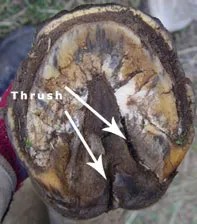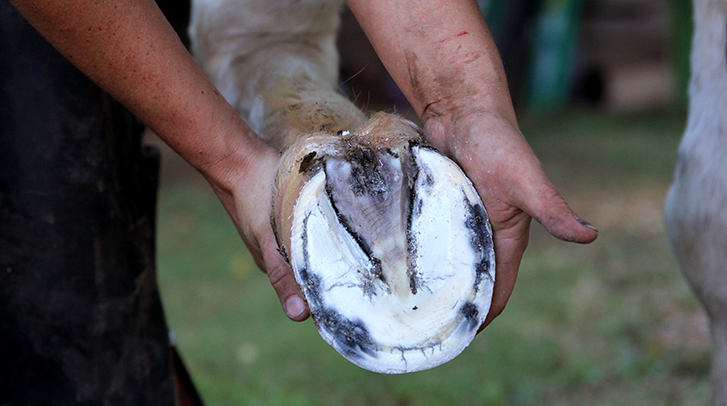Thrush in the horse
Thrush is an infection in the frog and the grooves (sulci) in and around the frog of the hoof. It can be caused by various organisms like fungus and anaerobic bacteria. One species of bacteria, Fusobacterium necrophorum, can destroy the frog and cause permanent damage if not treated early.
Thrush is black in appearance, sticky, and has a characteristic pungent smell. Horses that have deep sulci and poor hoof conformation are more prone to thrush. Wet weather is also a breeding ground for “thrushy feet” in horses.
Muddy paddocks and increased stabling can all lead to thrush in the hoof. Horses’ hooves have fungus and bacteria on them normally, but when their feet are exposed to prolonged contact with a damp contaminated (manure and urine) environment, the hoof becomes soft and allows the microorganisms to penetrate into the sensitive parts of the foot potentially causing infection. The frog will become inflamed and painful as the infection progresses. You may even notice blood when you clean out your horse’s foot as the tissue deteriorates.

How to treat thrush.
Prevention is the best cure for thrush and most diseases of the hoof. Here are some things you can do to prevent infections in the hoof:
- Pick out your horses’ feet daily and brush out debris.
- Make sure hoof picks and brushes are kept clean. Prevent cross contamination to other horses.
- Keep stables and paddocks clean and as dry as possible.
- Use an antibacterial antifungal hoof dressing regularly.
- Have feet trimmed regularly.
- Make sure your horse has a balanced diet for maximum hoof health.
- Treat any metabolic disorders like PPID (Cushing’s disease). A horse with a compromised immune system is more prone to foot infections.
Even the most conscientious horse owner can still have a horse with thrush, so how do we treat it even if we have done everything, we can to prevent it?
Have your vet or farrier trim away any dead tissue and make sure your tetanus vaccinations are up to date. If the infection and damage are really bad, your vet may recommend bandaging and antibiotics, but this is rare.
Gently scrub the hoof daily with iodine scrub until the infection is gone. This will kill any microorganisms and help to dry out the foot. The bacteria that cause the infection hate air. Use an old toothbrush to really get into the grooves.
Thoroughly dry the foot as well as you can. Iodine solution can then be painted on to keep treating the infection in between daily scrubbing. It should not take longer than a couple weeks to completely treat the infection.

Written by Neely Hopkins
Experts in Equine Nutrition
Every product in the Ranvet range has been developed to meet a horse’s most specific need at any given time, be it in a training environment or on a breeding farm. Having pioneered the formulation of specific medications and dietary supplements for horses, the company is now recognised as a leader in the areas of equine health and nutrition.
